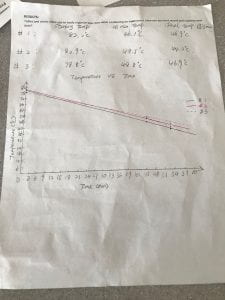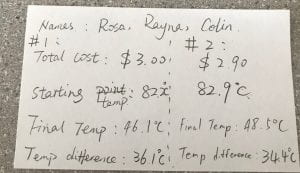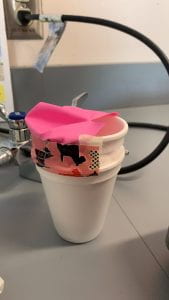






#1: one balloon, 2 Styrofoam cups, 7 inch masking tape, 4 cotton balls, 10g sand. Total cost is $3.
The idea behind this prototype is to reduce heat loss through heat transfer, so we use a lot of materials that has less thermal conductively, so the conduction of heat through the contact between the hot water and the material becomes weaker and slower. 
#2: 2 styrofoam cups, 8 inch aluminum foil, 4 inch masking tape, 4 cotton balls. Total coast is $2.9.
We made the second idea based on the first one to reduce heat transfer and enhance the heat reflection in the inner layer. Since aluminum foil has very strong thermal conductively, if used in inner layer, it can strengthen thermal reflection and achieve the effect of “reheating” to keep heat.The lid is made of aluminum foil, on the one hand, because of material price, on the other hand, because in the interior of the water can produce heat loss by convection, high quantity of heat of water molecules have higher molecular kinetic energy will move to the surface, if there is no lid can cause a lot of heat loss, and we want to use radiation of aluminum foil to reduce heat loss. 
#3: 2 cotton balls, 1 styrofoam cup, 2 inch masking tape, 25 square inch aluminum foil, one paint layer, half paper towel, 3 cotton balls. Total cost is $2.9.
Third major is the union of one idea and improve, because more than two only focuses on the practice of a kind of heat preservation, we in the inside of the paint instead of the aluminum, the second is to strengthen the same radiation heat so as to achieve “heating water again” inner heat preservation effect, while the outer layer is the second in the foam cup instead of into the aluminum foil, aluminum foil and cotton balls combination can better achieve the effect of heat preservation in outer. 
Overall, water in the prototype lose heat main is by conduction, so we are doing the project’s main idea is to use less thermal conductivity of materials to reduce heat conduction, so each of our design in outer do have “shell”, and through the results of the first we knew, the “shell” is not enough to reduce conduction, we need to strengthen inside , so we adopt with radiation heat material for “heating water again”.And at the top of the design is similar to the cup body, is also using thermal conductivity less to reduce heat loss. But the second main consideration is the use of radiation, which reflects heat, to conserve it.










